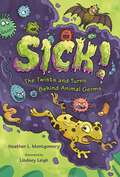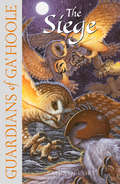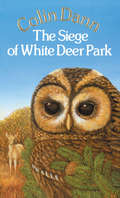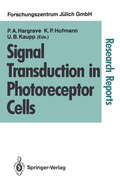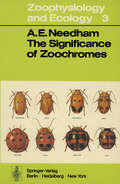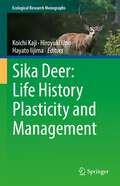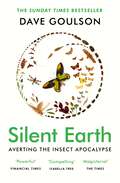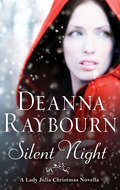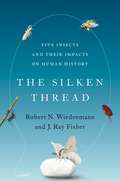- Table View
- List View
The Siberian Sturgeon (Acipenser baerii, Brandt, 1869) Volume 2 - Farming
by Patrick Williot Guy Nonnotte Mikhail ChebanovThe Siberian sturgeon, Acipenser baerii Brandt 1869 is the most widely farmed sturgeon species. Continuing from Volume 1, which focuses on the biology of the species, the present Volume 2 in turn examines farming aspects. It is divided into six parts, the first of which deals with reproduction and early ontogenesis, i.e. reproductive cycles, controlled reproduction, sperm cryoconservation, and weaning of larvae. The second covers the growing phase with a focus on food and feeding (management, fish meal replacement, potential endocrine disruptions, usefulness of prebiotics and immunostimulants, and nitrogen excretion). Production-related data are the focus of the third part and include: characteristics (countries, structures of production, evolution in production, economic features) of the gross production of the species (meat and caviar) worldwide, a method for assessing the quality of caviars, off-flavors management, and an example of production of fingerlings for restocking. Part four addresses selected long-term management issues: genetic variability of brood stocks, genome manipulation and sex control, and the advantages of hybrids. The next three chapters constitute the fifth part, which is devoted to health status (immunology and welfare). In closing, the absence of ecological risks of introducing the species in non-native waters is shown using two long-term documented examples (Russia and France). Three methodological chapters round out the volume, covering: in vitro incubation of ovarian follicles, a richly illustrated library of echographies and photos, and a detailed presentation of oxygen demand studies.
Sick!: The Twists and Turns Behind Animal Germs
by Heather L. MontgomeryWhen a super sickness lands on the land, when a parasite becomes more than a pest, when an infection ignites an epidemic, what's a body to do? Your body is an animal body, so why not ask the animals?Follow the scientists, around the world and into their labs, who are studying animals and the germs that attack them. From fungus-ridden frogs with fevers to bacteria-resistant buzzards and everything in-between, animals have A LOT to teach us about infections. But-reader beware!!-the story of germs is filled with twists and turns.In this fascinating, highly visual nonfiction book packed with colorful, comic-style art, you'll discover not only the cool ways that animal bodies (and our bodies) fight back against pesky pathogens, but also the amazing and surprising ways we can learn to work together with germs.Sick! The Twists and Turns Behind Animal Germs is written by Heather L. Montgomery with graphic novel-style art from Lindsey Leigh.
Sick!: The Twists and Turns Behind Animal Germs
by Heather L. MontgomeryWhen a super sickness lands on the land, when a parasite becomes more than a pest, when an infection ignites an epidemic, what's a body to do? Your body is an animal body, so why not ask the animals?Follow the scientists, around the world and into their labs, who are studying animals and the germs that attack them. From fungus-ridden frogs with fevers to bacteria-resistant buzzards and everything in-between, animals have A LOT to teach us about infections. But-reader beware!!-the story of germs is filled with twists and turns.In this fascinating, highly visual nonfiction book packed with colorful, comic-style art, you'll discover not only the cool ways that animal bodies (and our bodies) fight back against pesky pathogens, but also the amazing and surprising ways we can learn to work together with germs.Sick! The Twists and Turns Behind Animal Germs is written by Heather L. Montgomery with graphic novel-style art from Lindsey Leigh.
The Siege: The Siege (Guardians of Ga’Hoole #4)
by Kathryn LaskyFourth title in a mythic adventure series in which the heroes are owls!
The Siege Of White Deer Park (The\farthing Wood Ser. #Vol. 5)
by Colin DannTerror has come to White Deer Park, driving panic-stricken animals before it. A killer beast is on the loose - a predator so silent and skillful that it leaves almost no trace, and has never been seen.As the deaths mount up, Owl, Fox, Badger and the elders of Farthing Wood meet to make a plan. They have fought tough corners before; have they now, finally, met their match?
Signal Transduction in Photoreceptor Cells: Proceedings of an International Workshop Held at the Research Centre Jülich, Jülich, Fed. Rep. of Germany, 8–11 August 1990 (Research Reports in Physics)
by Paul A. Hargrave Klaus P. Hofmann U. Benjamin KauppThis book deals with the mechanism of signal transduction in vertebrate and invertebrate photoreceptors. It contains contributions on the structure and function of rhodopsin or other G-coupled receptors, on the regulation of second messengers by enzyme cascade, the role of Ca2+ in light adaptation, control of ionic channels in photoreceptor cells.
Signalers and Receivers: Mechanisms and Evolution of Arthropod Communication
by Michael D. GreenfieldIn most terrestrial and aquatic habitats, the vast majority of animals transmitting and receiving communicative signals are arthropods. This book presents the story of how this important group of animals use pheromones, sound, vibration, and light for sexual and social communication. Because of their small to minute body size most arthropods have problems sending and receiving acoustic and optical information, each of which have their own severe constraints. Because of these restraints they have developed chemical signaling which is not similarly limited by scale. Presenting the latest theoretical and experimental findings from studies of signaling, it suggests that close parallels between arthropods and vertebrates reflect a very limited number of solutions to problems in behavior that are available within the confines of physical laws.
Signaling Mechanisms in Protozoa and Invertebrates (Progress in Molecular and Subcellular Biology #17)
by G. Csaba W. E. G. MüllerComparative endocrinology helps to find the roots of homeostatic regulation in organisms. In this context, many years ago a series of experiments were done, which demonstrated the hormonal regula tion also on the invertebrate level. The mechanisms are partly similar, partly different, from those found in vertebrates. The new receptor era of mammalian endocrinology stimulated research on invertebrate hormone receptors, and sophisticated methods are applied also to determine hormones. The experiments demonstrated the existence and even similar function of these structures and signaling molecules. However, data on hormones and receptors at the lowest level of metazoan life and the highest level of protozoan life were not at our disposal. About two decades ago, first observations on the presence of hormone receptors reacting to vertebrate hormones in protozoa were made. Since the early 1980s we know that hormone-like molecules similar to those of higher vertebrates are present also in unicellular organisms. The presence of some second messengers in Tetrahymena was recognized. Since then, the research has been extended and many structures - previously believed to be solely vertebrate characteristics, such as opiate receptors, similar to mammalian ones - were found in unicellular organisms. These observations justified the assumption of a complete endocrine system at protozoan level, where - considering the unicellularit- this seemed to be not required. However, it became clear that the roots of endocrine communication date back at least 2 billion years.
Signals and Images: Contributions and Contradictions about High Dilution Research
by Leoni Villano BonaminThe “Groupe International de Recherche sur l’Infinitésimal” (GIRI) was created in 1986 by Professor Madeleine Bastide and Doctor René Halm. Madeleine Bastide was its President for several years. The group comprises actually more than 100 researchers from different disciplines (physicians, chemists, biologists, pharmacologists, physicists, etc. ) from 22 different countries. The original aim, which, for the most part, has now been achieved, was to create a working group to exchange ideas and results concerning the effects of very low doses and high dilutions. Madeleine Bastide then proposed to publish a collection of the lectures given at their scientific meetings in a bilingual book (French and English) entitled “Signals and Images”. The first volume was published in 1990 by the ATELIERS ALPHA BLEUE. It contains lectures on the new pharmacological approach and related concepts that were presented at the 3rd and 4th Symposiums held in Paris in 1989 and 1990. This volume treats the problem of the effects of very low doses and high dilution in in vitro and in vivo experimental models. It is conceivable that this effect, like that of elect- magnetic fields, is none other than an “ultra molecular” effect as shown in yet p- lished results. The effect could be interpreted as a piece of information, i. e. a signal whose transmission and perception remains to be elucidated. According to Madeleine Bastide “everything depends on the nature and quality of the information, signals and images”.
The Significance of Zoochromes (Zoophysiology #3)
by A.E. NeedhamAs the title indicates, the theme of this book is the functions of biochromes in animals. Recent works on zoochromes, such as those of D. L. Fox (1953), H. M. Fox and VEVERS (1960) and VUILLAUME (1969), have been concerned primarily with the chemical nature and the taxonomic distribution of these materials, and although function has been considered where relevant this has not been the centre of interest and certainly not the basis for the arrangement of the subject matter. Functional significance is a profitable focus of interest, since it is the one theme which can make biochromatology a discrete and integral subject, and because it is the main interest in all biological fields. At present chromatology seems to be a particularly schizoid subject since it is clear that in metabolic functions biochromes are acting in a chemical capacity whereas integumental pigments function mainly biophysically, in neurological and behavioural contexts. It is profitable to attempt an integration by studying the functions of as many chromes as possible, from all aspects.
Sigrid Rides: The Story of an Extraordinary Friendship and An Adventure on Two Wheels
by Travis Nelson'A one-man, one-cat mission to cheer people up' - The Mirror When Travis Nelson arrived in London, he expected to embark on a new life and a new job. Coming from California, he'd uprooted his wife and his cat, Sigrid, and planned to be here for the long haul. Then Covid-19 struck. Travis's new job vanished as the company cut staff. For two years, and through successive lockdowns, he was stuck in limbo in an unfamiliar city, trying to find his way.To keep himself occupied, Travis set out to discover his adoptive home. He bought a bike and began cycling through London's streets and parks with his unusual travelling companion, Sigrid - his deaf, Norwegian Forest cat - who came along for the ride. But what started as a way of injecting routine and purpose into Travis's life in stressful times, created an internet sensation. When Travis began posting videos of the pair's rides on social media, he drew in another community of people looking for moments of joy in an anxious world.In this charming memoir, Travis charts his adventures with Sigrid. He unlocks a hidden London seen only from cyclist's viewpoint, as well as finding friendship and hope. Most of all, it is the story of one man's relationship with his feline companion - one that has given him direction and a sense of belonging at a time when he felt lost.
Sika Deer: Biology and Management of Native and Introduced Populations
by Dale R. McCullough Seiki Takatsuki Koichi KajiSika deer, the graceful spotted deer of Japanese and Chinese art, originally were native to Asia from far-east Russia to Vietnam to the islands of Japan and Taiwan. They are widely raised in captivity to supply velvet antler for traditional medicine. They also were introduced to Europe, North America, and New Zealand, where they compete or interbreed with native deer. Sika deer typically occupy lowland hardwood forests with low winter snow depths, where they thrive in sites disturbed by fire, storm, or logging. In high numbers they can severely impact vegetation though overgrazing, stripping bark from trees and damaging crop fields and forest plantations. Their numbers are high in many parts of Japan, moderate in Russia, and reduced or extinct in the wild in China, Korea, Vietnam, and Taiwan. This book explores their basic biology, behavior, and ecology, including management for sport hunting, conservation or recovery of threatened populations, and resolution of conflict with humans in native and introduced lands.
Sika Deer: Life History Plasticity and Management (Ecological Research Monographs)
by Koichi Kaji Hiroyuki Uno Hayato IijimaThis book provides complete and up-to-date information on sika deer biology and its management, focusing on their life history with an integrated approach of population dynamics, morphology, genetics, and evolution. The expanding distribution of sika and its increase in population in Japan and other countries are causing damage to agriculture and forestry, impacting ecosystems and affecting other species. We are facing conflicting deer issues regarding the conservation of resource values and pest control of sika deer. This contributed volume compiles new findings focusing on the ecological plasticity of the sika deer. It aims to clarify the ecological characteristics of the deer by integrating studies of different approaches and provides a perspective for their management. The book consists of six parts. Part I introduces the ecological and management background behind the history of sika deer. The following four parts discuss movement ecology (Part II), impact on vegetation and bottom-up effect on sika deer (Part III), impact on ecosystem and its resilience (Part IV), and comparison of life-history characteristics between sika deer and other ungulate species (Part V). The last part (Part VI) covers the science-based management of sika deer. Contributed by recognized experts and young researchers of sika deer, this book appeals to researchers and professionals in wildlife biology and wildlife management, evolution, population dynamics, morphology, genetics, and reproductive physiology.
Silencing, Heterochromatin and DNA Double Strand Break Repair
by Kevin D. MillsThe field of DNA repair is vast and advancing rapidly. Recent investigations have begun to focus on the involvement of chromatin in the repair of broken DNA. Although I have no doubt that many breakthroughs in our understanding of chromatin, chromatin regulation, and DNA repair lie in our future, presently this is a new line in inquiry. As such there are many, many unanswered questions. Indeed, most of the correct questions have probably not even been asked yet. Here I have attempted to present a review of some of the current body of knowledge that may prove relevant to understanding the role of chromatin in DNA repair. Because the volume of research, and the relevant findings, come from a staggering array of labs, systems, and ideas I have focused primarily on findings developed from the study of the budding yeast Saccharomyces cerevisiae. Unfortunately, this means that I have left out a great deal of information. It is my hope, however, that the information I do detail, particularly in Chapter 1, will give a flavor for the scope of the problem and perhaps highlight some of the interesting directions this field is taking, or may one day take. I would also point out that the primary research that is presented herein is not in any way meant to represent the comprehensive scope of research being performed. To understand DNA repair will require investigation from innumerable labs, performed by innumerable researchers, moving in unexpected directions.
Silent Earth: Averting the Insect Apocalypse
by Dave Goulson'Compelling, penetrating, devastating - Silent Earth is a wake-up call for the world.' Isabella TreeInsects are essential for life as we know it. As they become more scarce, our world will slowly grind to a halt; we simply cannot function without them. Drawing on the latest ground-breaking research and a lifetime's study, Dave Goulson reveals the shocking decline of insect populations that has taken place in recent decades, with potentially catastrophic consequences. He passionately argues that we must all learn to love, respect and care for our six-legged friends. Eye-opening, inspiring and riveting, Silent Earth is part love letter to the insect world, part elegy, part rousing manifesto for a greener planet. It is a call to arms for profound change at every level - in government policy, agriculture, industry and in our own homes and gardens. Although time is running out, it is not yet too late for insect populations to recover. We may feel helpless in the face of many of the environmental issues that loom on our horizon, but Goulson shows us how we can all take simple steps to encourage insects and counter their destruction.
Silent Night: A Lady Julia Christmas Novella (A Lady Julia Grey Novel #6)
by Deanna Raybourn'Tis the season for an investigation! Lady Julia and Nicholas Brisbane return for a Christmas caper at Bellmont Abbey–.
Silent Sparks: The Wondrous World of Fireflies
by Sara LewisFor centuries, the beauty of fireflies has evoked wonder and delight. Yet for most of us, fireflies remain shrouded in mystery: How do fireflies make their light? What are they saying with their flashing? And what do fireflies look for in a mate? In Silent Sparks, noted biologist and firefly expert Sara Lewis dives into the fascinating world of fireflies and reveals the most up-to-date discoveries about these beloved insects. From the meadows of New England and the hills of the Great Smoky Mountains, to the rivers of Japan and mangrove forests of Malaysia, this beautifully illustrated and accessible book uncovers the remarkable, dramatic stories of birth, courtship, romance, sex, deceit, poison, and death among fireflies.The nearly two thousand species of fireflies worldwide have evolved in different ways—and while most mate through the aerial language of blinking lights, not all do. Lewis introduces us to fireflies that don't light up at all, relying on wind-borne perfumes to find mates, and we encounter glow-worm fireflies, whose plump, wingless females never fly. We go behind the scenes to meet inquisitive scientists who have dedicated their lives to understanding fireflies, and we learn about various modern threats including light pollution and habitat destruction. In the last section of the book, Lewis provides a field guide for North American fireflies, enabling us to identify them in our own backyards and neighborhoods. This concise, handy guide includes distinguishing features, habits, and range maps for the most commonly encountered fireflies, as well as a gear list.A passionate exploration of one of the world's most charismatic and admired insects, Silent Sparks will inspire us to reconnect with the natural world.
Silent Sparks: The Wondrous World of Fireflies
by Sara LewisFor centuries, the beauty of fireflies has evoked wonder and delight. Yet for most of us, fireflies remain shrouded in mystery: How do fireflies make their light? What are they saying with their flashing? And what do fireflies look for in a mate? In Silent Sparks, noted biologist and firefly expert Sara Lewis dives into the fascinating world of fireflies and reveals the most up-to-date discoveries about these beloved insects. From the meadows of New England and the hills of the Great Smoky Mountains, to the rivers of Japan and mangrove forests of Malaysia, this beautifully illustrated and accessible book uncovers the remarkable, dramatic stories of birth, courtship, romance, sex, deceit, poison, and death among fireflies.The nearly two thousand species of fireflies worldwide have evolved in different ways—and while most mate through the aerial language of blinking lights, not all do. Lewis introduces us to fireflies that don't light up at all, relying on wind-borne perfumes to find mates, and we encounter glow-worm fireflies, whose plump, wingless females never fly. We go behind the scenes to meet inquisitive scientists who have dedicated their lives to understanding fireflies, and we learn about various modern threats including light pollution and habitat destruction. In the last section of the book, Lewis provides a field guide for North American fireflies, enabling us to identify them in our own backyards and neighborhoods. This concise, handy guide includes distinguishing features, habits, and range maps for the most commonly encountered fireflies, as well as a gear list.A passionate exploration of one of the world's most charismatic and admired insects, Silent Sparks will inspire us to reconnect with the natural world.
Silent Spring Revisited
by Conor Mark JamesonAmerican scientist and author Rachel Carson is said to have sparked the modern day environmental movement with the publication of Silent Spring in 1962. She made vivid the prospect of life without birdsong. But has her warning been heeded? Fifty years on, Conor Mark Jameson reflects on the growth of environmentalism since Silent Spring was published. His revealing and engaging tale plots milestone events in conservation, popular culture and political history in the British Isles and beyond, tracing a path through the half century since 'zero hour', 1962. Around this he weaves his own observations and touching personal experiences, seeking to answer the question: what happened to the birds, and birdsong, and why does it matter?
The Silken Thread: Five Insects and Their Impacts on Human History
by Robert N. Wiedenmann J. Ray FisherInsects are seldom mentioned in discussions surrounding human history, yet they have dramatically impacted today's societies. This book places them front and center, offering a multidisciplinary view of their significance. Diseases vectored by insects have killed more people than all weapons of war. Fleas are common pests, but some can transmit illnesses such as the bubonic plague. In fact, three pandemics can be traced back to them. Epidemics of typhus have been caused by lice. Conversely, humans have also benefitted from insects for millennia. Silk comes from silkworms and honey comes from bees. Despite the undeniably powerful effects of insects on humans, their stories are typically left out of our history books. In The Silken Thread, entomologists Robert. N. Wiedenmann and J. Ray Fisher link the history of insects to the history of empires, cultural exchanges, and warfare. The book narrows its focus to just five insects: a moth, a flea, a louse, a mosquito, and a bee. The authors explore the impact of these insects throughout time and the common threads connecting them. Using biology to complement history, they showcase these small creatures in a whole new light. On every page, the authors thoughtfully analyze the links between history and entomology. The book begins with silkworms, which have been farmed for centuries. It then moves to fleas and their involvement in the spread of the plague before introducing the role lice played in the Black Death, wars, and immigration. The following section concerns yellow fever mosquitos, emphasizing the effects of yellow fever in the Americas and the connection to sugar and slavery. After discussing the importance of western honey bees, the authors tie these five insects together in an exciting closing chapter.
The Silken Thread: Five Insects and Their Impacts on Human History
by Robert N. Wiedenmann J. Ray FisherInsects are seldom mentioned in discussions surrounding human history, yet they have dramatically impacted today's societies. This book places them front and center, offering a multidisciplinary view of their significance. Diseases vectored by insects have killed more people than all weapons of war. Fleas are common pests, but some can transmit illnesses such as the bubonic plague. In fact, three pandemics can be traced back to them. Epidemics of typhus have been caused by lice. Conversely, humans have also benefitted from insects for millennia. Silk comes from silkworms and honey comes from bees. Despite the undeniably powerful effects of insects on humans, their stories are typically left out of our history books. In The Silken Thread, entomologists Robert. N. Wiedenmann and J. Ray Fisher link the history of insects to the history of empires, cultural exchanges, and warfare. The book narrows its focus to just five insects: a moth, a flea, a louse, a mosquito, and a bee. The authors explore the impact of these insects throughout time and the common threads connecting them. Using biology to complement history, they showcase these small creatures in a whole new light. On every page, the authors thoughtfully analyze the links between history and entomology. The book begins with silkworms, which have been farmed for centuries. It then moves to fleas and their involvement in the spread of the plague before introducing the role lice played in the Black Death, wars, and immigration. The following section concerns yellow fever mosquitos, emphasizing the effects of yellow fever in the Americas and the connection to sugar and slavery. After discussing the importance of western honey bees, the authors tie these five insects together in an exciting closing chapter.
Silkworm Biofactory: Silk to Biology (Industrial Biotechnology)
by Katsumi Maenaka Enoch Y. ParkWhile silk derived from silkworm has been of economic importance for centuries, more recently silkworm has been found to have utility in biomedicine. This has attracted attention for expressing eukaryotic recombinant proteins, which require post-translational modifications. In 1985 Dr. Susumu Maeda demonstrated that silkworm larvae could produce a functional human-interferon. Since then various techniques have been developed to express recombinant proteins in silkworm. With the development of the Bombyx mori nucleopolyhedrovirus (BmNPV) bacmid system, which is capable of replicating in both Escherichia coli and Bombyx mori derived cell lines or silkworm, silkworm larvae or pupae have been used for the expression system for recombinant protein production. This method has the advantage of a bacmid, in that it can be easily prepared for sufficient bacmid DNA for subsequent expression in silkworm. It is potentially a big breakthrough in production of recombinant eukaryotic proteins and viruses, which will be a powerful tool in a new proteome era. This volume contributes to the advancement of our knowledge in the subject, for example gene expression systems and silkworm research, and focuses on silkworm biofactories for the recombinant protein production and commercial applications of proteins.
Silkworm Biofactory: Silk to Biology (Industrial Biotechnology)
by Enoch Y. Park Katsumi MaenakaWhile silk derived from silkworm has been of economic importance for centuries, more recently silkworm has been found to have utility in biomedicine. This has attracted attention for expressing eukaryotic recombinant proteins, which require post-translational modifications. In 1985 Dr. Susumu Maeda demonstrated that silkworm larvae could produce a functional human-interferon. Since then various techniques have been developed to express recombinant proteins in silkworm. With the development of the Bombyx mori nucleopolyhedrovirus (BmNPV) bacmid system, which is capable of replicating in both Escherichia coli and Bombyx mori derived cell lines or silkworm, silkworm larvae or pupae have been used for the expression system for recombinant protein production. This method has the advantage of a bacmid, in that it can be easily prepared for sufficient bacmid DNA for subsequent expression in silkworm. It is potentially a big breakthrough in production of recombinant eukaryotic proteins and viruses, which will be a powerful tool in a new proteome era. This volume contributes to the advancement of our knowledge in the subject, for example gene expression systems and silkworm research, and focuses on silkworm biofactories for the recombinant protein production and commercial applications of proteins.
Silly Cats: A Ridiculous Collection of the World's Goofiest Cats and Most Relatable Memes
by Summersdale PublishersCats are packed with purrsonality, and this book celebrates exactly that. From funny faces to bizarre body positions, silly scenarios to ridiculous reactions, this collection of cat photos will entertain feline fanatics and animal whisperers alike.

